 Enterprise SSD solutions that incorporate eMLC NAND memory are an area of active innovation with a variety of players bringing solutions to market. PureSi is looking to carve out an eMLC niche with its new Kage K1, a 2.5-inch SATA 3.0 SSD that will be offered in a variety of capacities from 50GB to 400GB. We’ve been putting a 200GB Kage K1 through its paces for a few weeks in order to see how PureSi’s eMLC solution stacks up to comparables from incumbents Hitachi, Intel, and Samsung.
Enterprise SSD solutions that incorporate eMLC NAND memory are an area of active innovation with a variety of players bringing solutions to market. PureSi is looking to carve out an eMLC niche with its new Kage K1, a 2.5-inch SATA 3.0 SSD that will be offered in a variety of capacities from 50GB to 400GB. We’ve been putting a 200GB Kage K1 through its paces for a few weeks in order to see how PureSi’s eMLC solution stacks up to comparables from incumbents Hitachi, Intel, and Samsung.
Enterprise SSD solutions that incorporate eMLC NAND memory are an area of active innovation with a variety of players bringing solutions to market. PureSi is looking to carve out an eMLC niche with its new Kage K1, a 2.5-inch SATA 3.0 SSD that will be offered in a variety of capacities from 50GB to 400GB. We’ve been putting a 200GB Kage K1 through its paces for a few weeks in order to see how PureSi’s eMLC solution stacks up to comparables from incumbents Hitachi, Intel, and Samsung.
The K1 uses a SandForce SF-2582VB1-SCC controller and Toshiba 24nm eMLC synchronous NAND. The 200GB Kage K1 SSD is specified for a lifetime 2,560 terabytes written and comes with a five year limited warranty. The StorageReview Enterprise Test Lab has been gathering benchmark results from our glowing collection of eMLC SSDs in order to make meaningful comparisons between similar products and to see how drives perform from fresh out of the box all the way into steady-state, showing their performance characteristics along the way.
During the review we will chart the performance of the 200GB Kage K1 against three other eMLC SSDs throughout our preconditioning and benchmarking protocol.
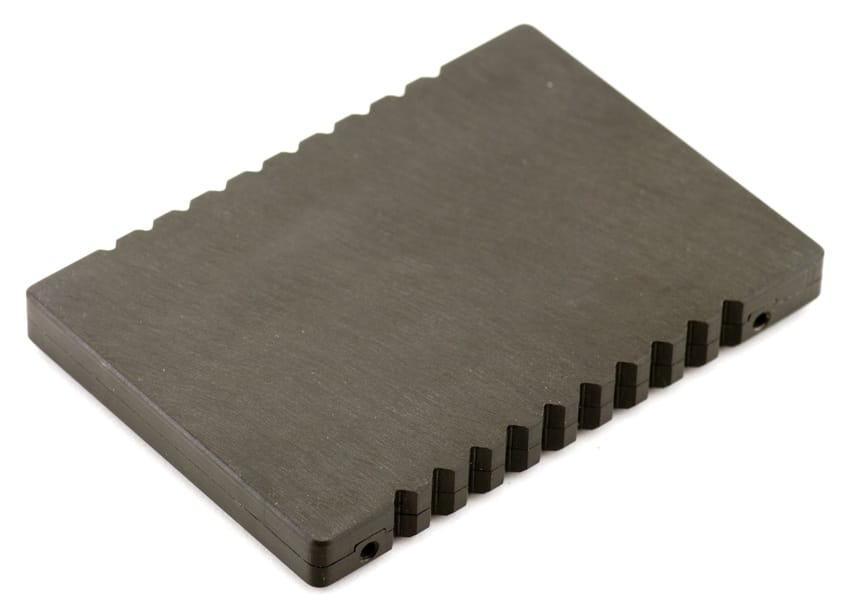
PureSi Kage K1 2.5-inch SSD Specifications
- Host Interface: Serial ATA 3.0 – 6Gb/s
- Interface Ports: Single
- Capacities: 50GB, 75GB, 100GB, 150GB, 200GB, 300GB, 400GB
- Sector Size: 512 Bytes
- Memory Type: Toshiba 24nm eMLC Synchronous NAND
- BCH ECC: 55-bits per 512-byte sector
- Encryption: AES-256 (FIPS-197 Certified) and TCG-Enterprise Supported
- Advanced power management and HIPM/DIPM support
- Performance
- Sequential Read (128K) – Up to 540MB/s
- Sequential Write (128K) – Up to 515MB/s
- Random Read (4K) – Up to 60,000 IOPS
- Random Write (4K) – Up to 60,000 IOPS
- Average Latency < 100 microseconds second
- Operating Temp: 0° C to +70° C
- Non-Operating Temp: -45° C to + 85° C
- Shock 1500 G, Duration 0.5 MS, Half Sine Wave Vibration 20 G Peak, 10 ~ 2000 Hz, x3 Axis
- Power Input – 5V DC
- Idle Power – 1.7W
- Typical Power – 3.5W
- Max Power – 5.5W
- Length 100.5 mm
- Height 7.0/9.5 mm
- Width 69.85 mm
Design and Dissassembly
One of the first things you appreciate about the K1 is its well-machined case. This design provides a distinctive look to the drive and thermal mass for heat dissipation, but it is notably heavier than many other 2.5-inch SSDs. Our review sample features a clean and simple top side along with a typical and informative label on the underside.
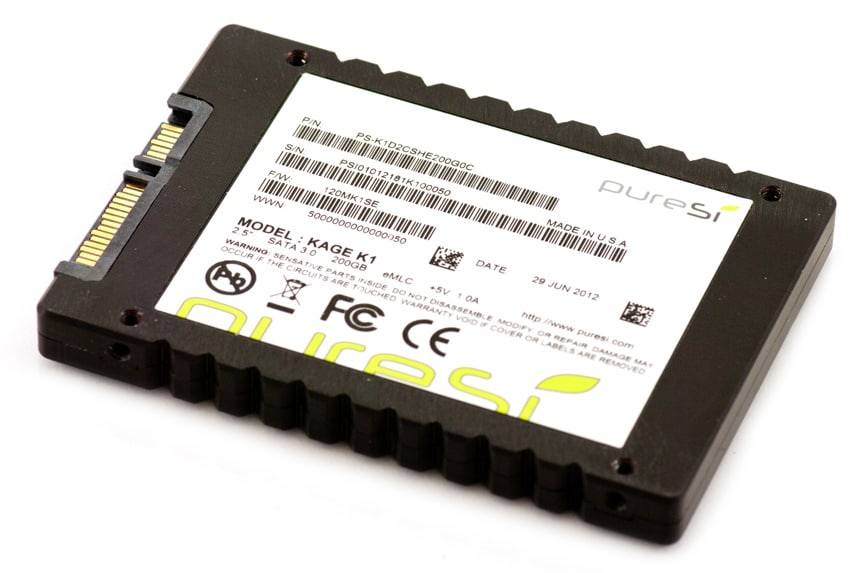
Kage K1 drives are being made in 7mm- and 9.5mm-high form factors. Our 200GB K1 sample measures 9.5mm tall.

With the drive disassembled it is possible to see the role the machined case plays in K1’s heat dissapation. Particular effort has been made in order to make sure that the surface of the controller makes good contact with the chassis.
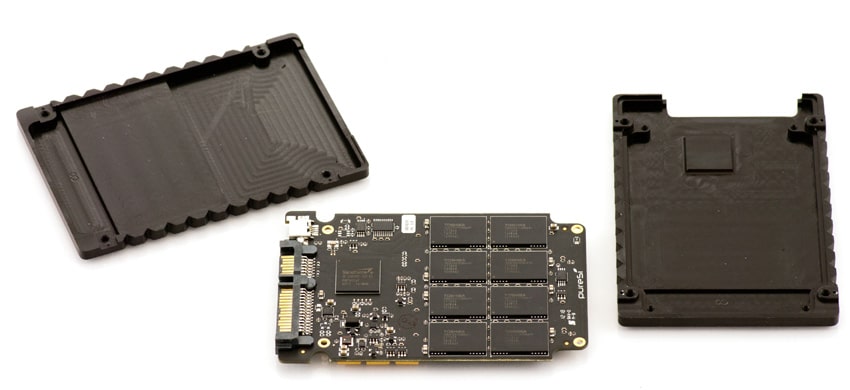
Another unique feature of the K1 is its use of thermal grease to ensure good thermal contact with the chassis. We typically see thermal pads playing this role on an SSD. As pureSi understandably did not design the chassis with user disassembly in mind, they also provided us a clean disassembled drive for reference.
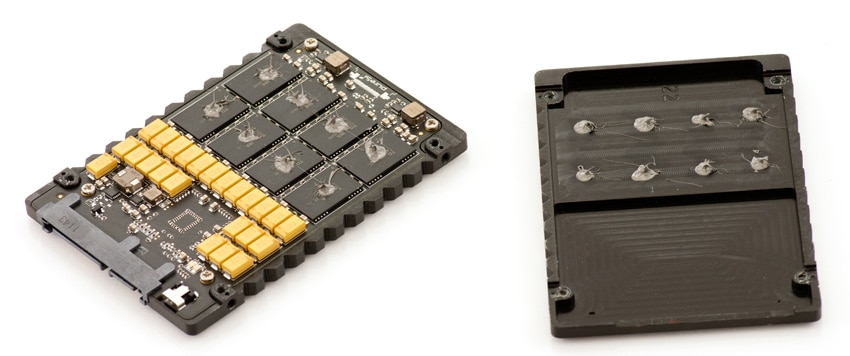
The Kage K1 SSD uses a SandForce SF-2582VB1-SCC multi-channel controller offering SATA 6.0Gb/s speeds.
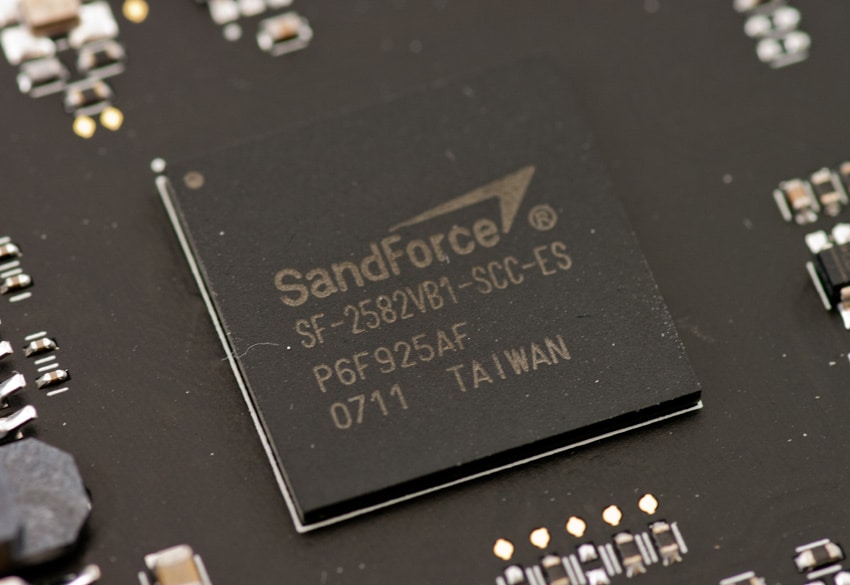
The top of the PCB features eight Toshiba TH58TE67E2HBA4C eMLC memory modules, as well as a hidden mini-USB service port.
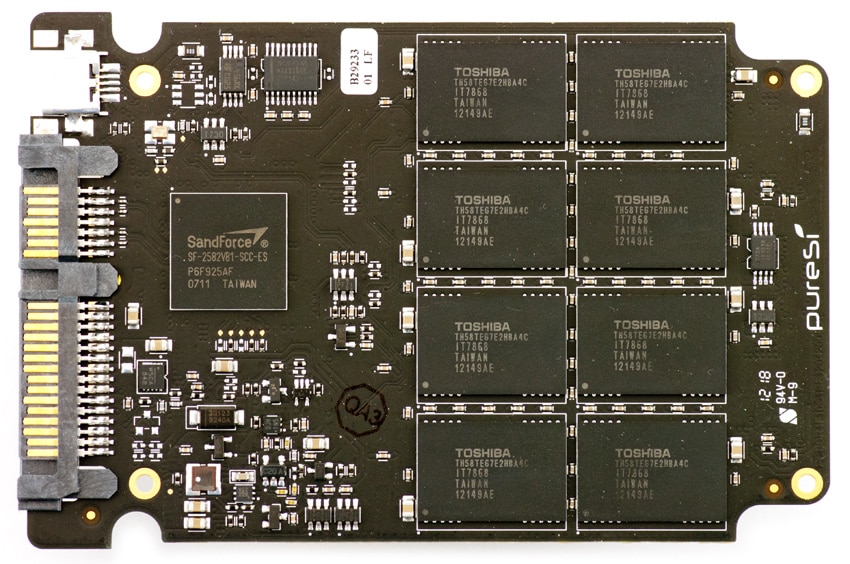
The bottom of the card features an additional eight memory modules as well as a bank of capacitors that prevent data loss during power failures.
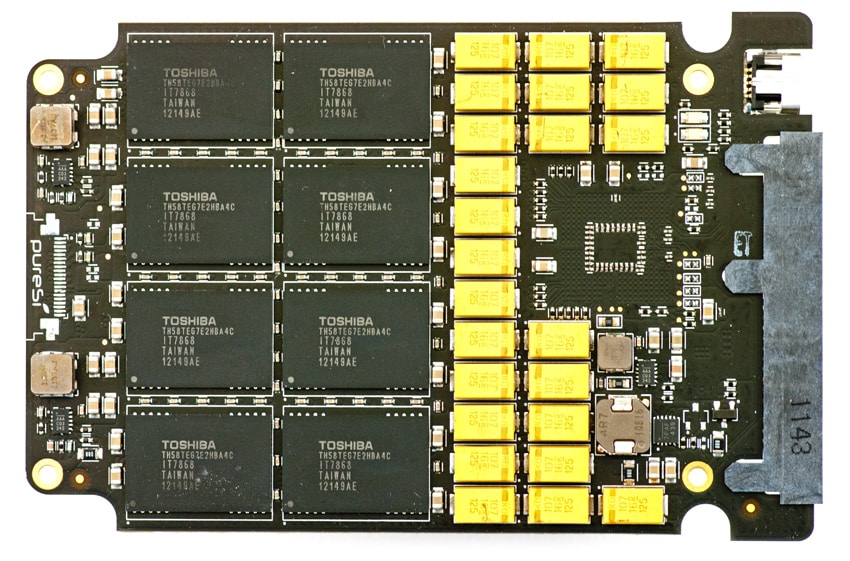
Testing Background and Comparables
Our PureSi 200GB Kage K1 SSD uses a SandForce SF-2582VB1-SCC controller and Toshiba 24nm eMLC synchronous NAND with a SATA 3.0 interface. Manufacturers continue to bring eMLC devices to market, and with a wide selection of comparables in our lab we are able benchmark drives like the Kage K1 against similarly-specified SSDs.
Comparables for this review:
- Intel SSD 710 (200GB, Intel PC29AS21BA0 controller, Intel 25nm eMLC NAND, 3.0Gb/s SATA)
- Samsung SM825 (200GB, Samsung S3C29MAX01-Y330 controller, Samsung 30nm eMLC NAND, 3.0Gb/s SATA)
- Hitachi SSD400M (400GB, Intel EW29AA31AA1 controller, Intel 25nm eMLC NAND, 6.0Gb/s SAS)
All enterprise SSDs are benchmarked on our enterprise testing platform based on a Lenovo ThinkServer RD240. The ThinkServer RD240 is configured with:
- 2 x Intel Xeon X5650 (2.66GHz, 12MB Cache)
- Windows Server 2008 Standard Edition R2 SP1 64-Bit and CentOS 6.2 64-Bit
- Intel 5500+ ICH10R Chipset
- Memory – 8GB (2 x 4GB) 1333Mhz DDR3 Registered RDIMMs
- LSI 9211 SAS/SATA 6.0Gb/s HBA
Enterprise Synthetic Workload Analysis
Flash performance varies throughout the preconditioning phase of each storage device. Our enterprise storage benchmark process begins with an analysis of the way the drive performs during a thorough preconditioning phase. Each of the comparable drives are secure erased using the vendor’s tools, preconditioned into steady-state with the same workload the device will be tested with under a heavy load of 16 threads with an outstanding queue of 16 per thread, and then tested in set intervals in multiple thread/queue depth profiles to show performance under light and heavy usage.
Preconditioning and Primary Steady-State Tests:
- Throughput (Read+Write IOPS Aggregate)
- Average Latency (Read+Write Latency Averaged Together)
- Max Latency (Peak Read or Write Latency)
- Latency Standard Deviation (Read+Write Standard Deviation Averaged Together)
Our Enterprise Synthetic Workload Analysis includes four profiles based on real-world tasks. These profiles have been developed to make it easier to compare to our past benchmarks as well as widely-published values such as max 4K read and write speed and 8K 70/30, which is commonly used for enterprise drives. We also included two legacy mixed workloads, the traditional File Server and Webserver, each offering a wide mix of transfer sizes.
- 4K
- 100% Read or 100% Write
- 100% 4K
- 8K 70/30
- 70% Read, 30% Write
- 100% 8K
- File Server
- 80% Read, 20% Write
- 10% 512b, 5% 1k, 5% 2k, 60% 4k, 2% 8k, 4% 16k, 4% 32k, 10% 64k
- Webserver
- 100% Read
- 22% 512b, 15% 1k, 8% 2k, 23% 4k, 15% 8k, 2% 16k, 6% 32k, 7% 64k, 1% 128k, 1% 512k
The Kage K1 settles into the lower 7000s IOps nearing steady state in the 4K preconditioning, higher only than the Intel SSD 710.
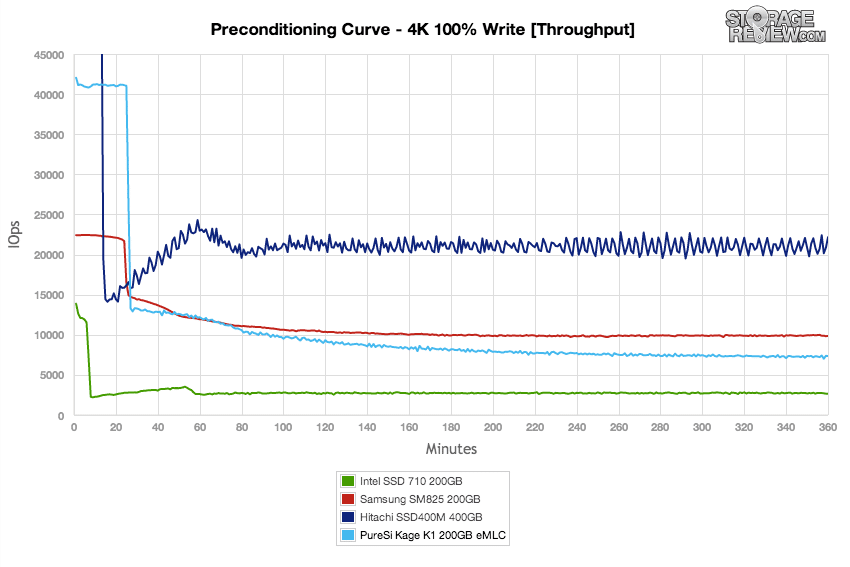
The K1 also comes in third place for average latency during 4K preconditioning, though its performance is not far from the Samsung SM825.
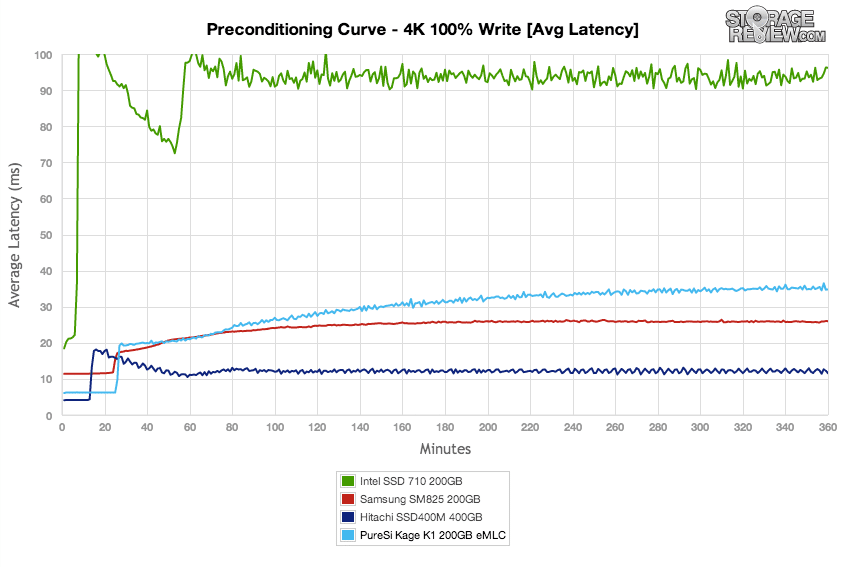
The K1‘s maximum latency suffers from spikes that keep it in the upper half of our scale on the maximum latency chart.
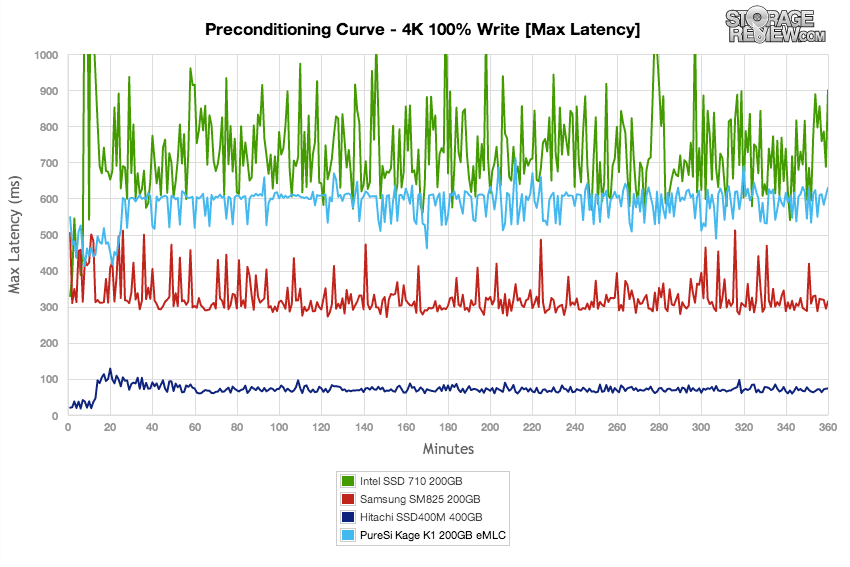
Charting standard deviation makes it easier to see how one-time latency spikes fit into the overall picture of performance. Plotted by standard deviation, it’s easier to see that the Kage K1 and the Samsung SM825 are peers when it comes to latency, with the SM825 edging out the K1 during 4K preconditioning.
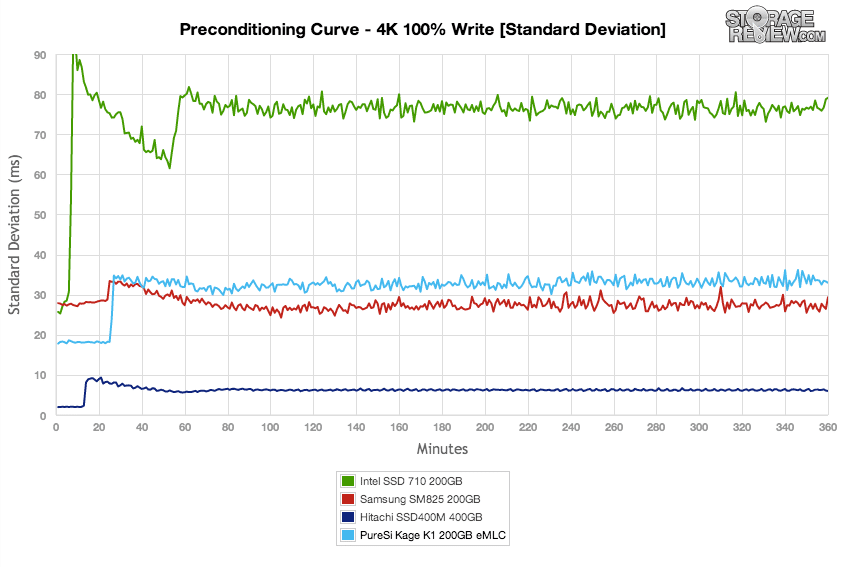
After the preconditioning process, we use a longer sample interval to measure the final read and write performance of each SSD since 4K operations are often used as a standard benchmark. With 16 threads and a queue of 16 the Kage K1 reached the second-highest read performance of 18,778 IOps and third place write throughput of 7,186 IOps.
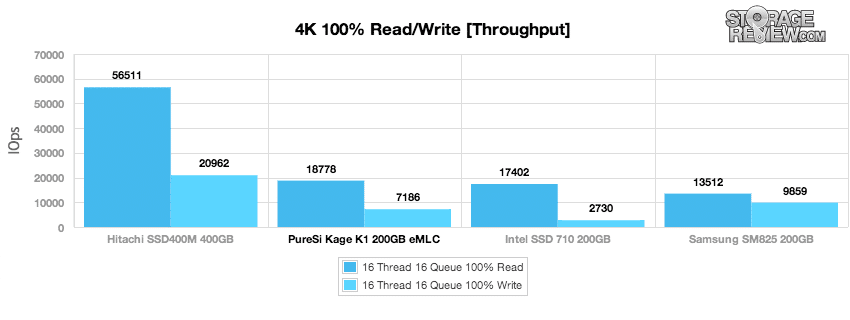
Its strengths in throughput are mirrored in the average latency, where the K1 scores well in read performance but falls into third position in write latency.
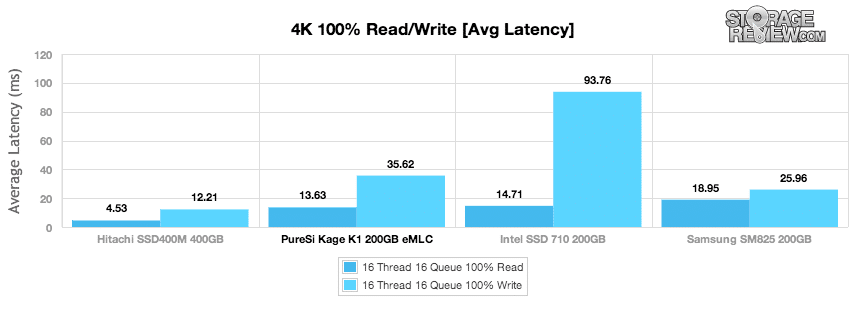
The K1‘s maximum latency spikes for write are higher than the non-Intel comparables, but it’s maximum latency in read operations is very competitive.
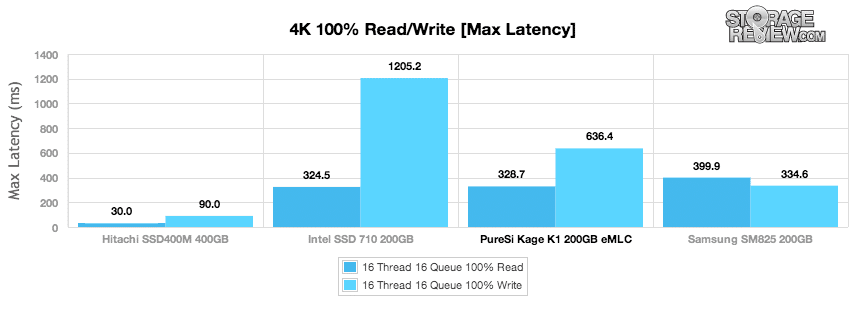
Plotted by standard deviation, the PureSi Kage K1 has similar 4K latency characteristics to the Samsung SM825.
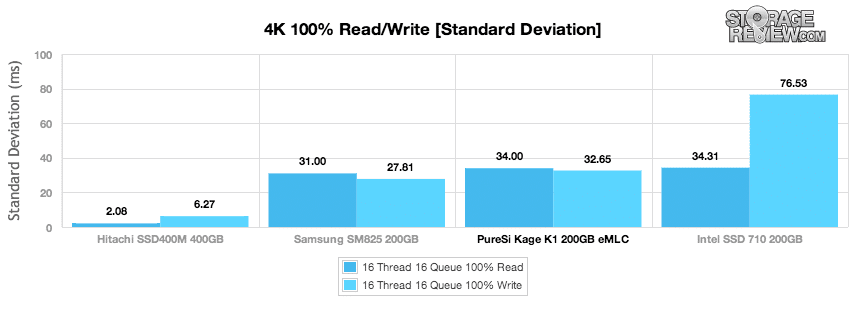
The 8K 70/30 test provides a more realistically diverse workload for enterprise storage.
With a workload more focused on the Kage K1’s strengths in read operations, it performs with or above the Intel SSD 710 and Samsung SM825 at the top of the preconditioning IOps chart.
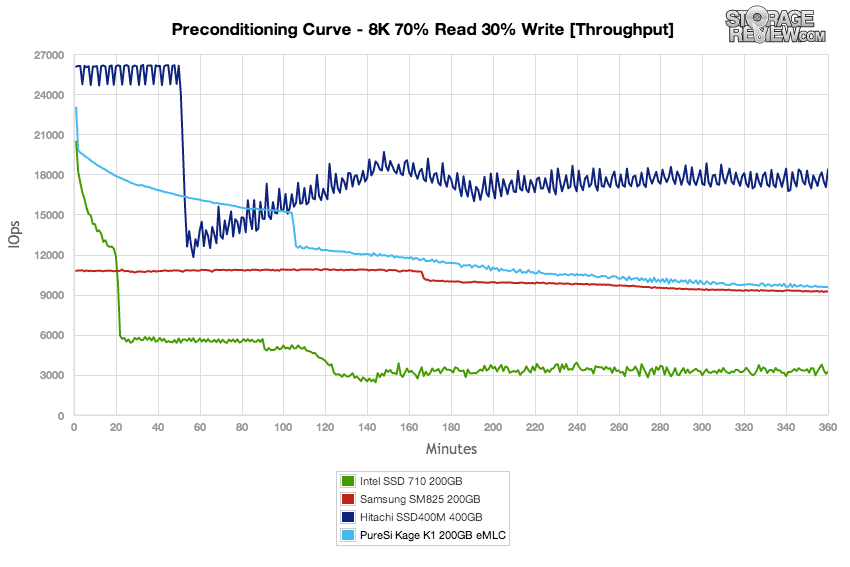
With average latency, the K1 once again sticks close to the Samsung SM825 in average latency during preconditioning for the 8K 70/30 test.
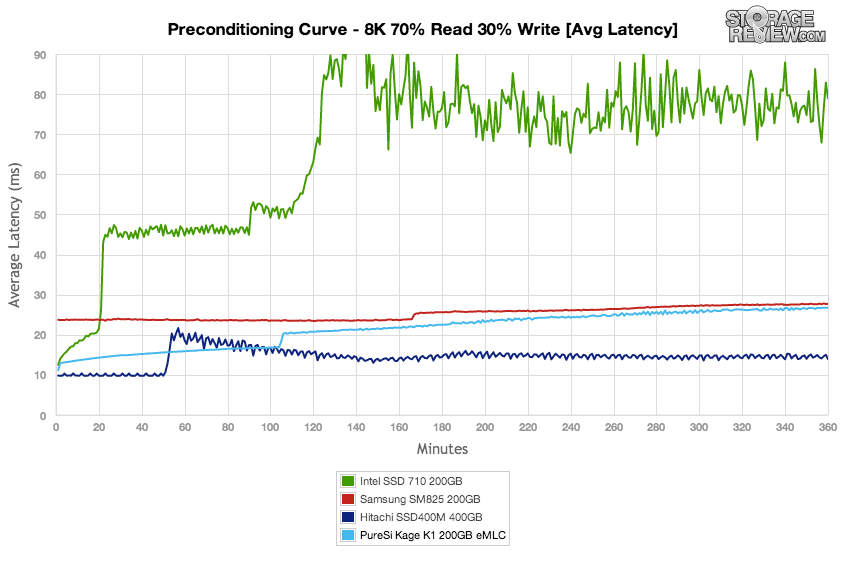
With the Intel SSD 710’s spikes increasing the scale on the maximum latency chart, the K1 and the Samsung SM825 look closer together than they would otherwise.
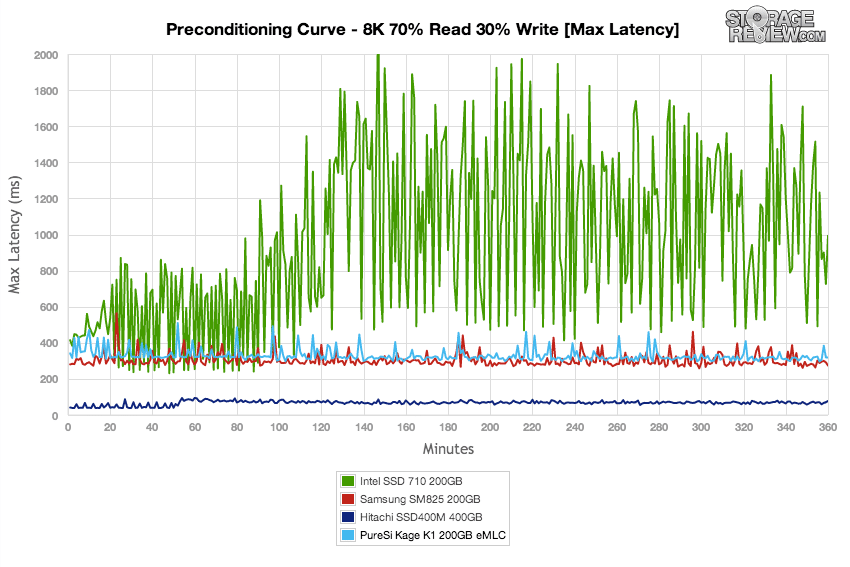
Plotted by standard deviation, the K1 has a distinctively higher latency than the comparables except for the SSD 710.
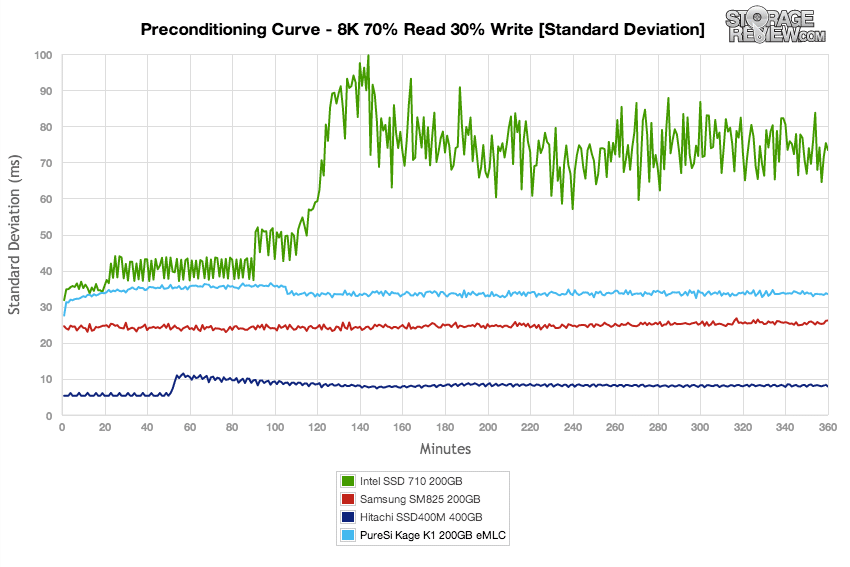
The workloads for the 8K 70/30 protocol differ from the 4K test in that we compare the performance of the drives across a range of thread and queue depth combinations. Workload intensity will scale from 2 threads and a queue of 2 up to 16 threads and a queue of 16.
Measured in terms of throughput, the Kage K1 can only keep up with the SM825 in certain tasks. Throughput is also not a strength for Intel’s SSD 710.
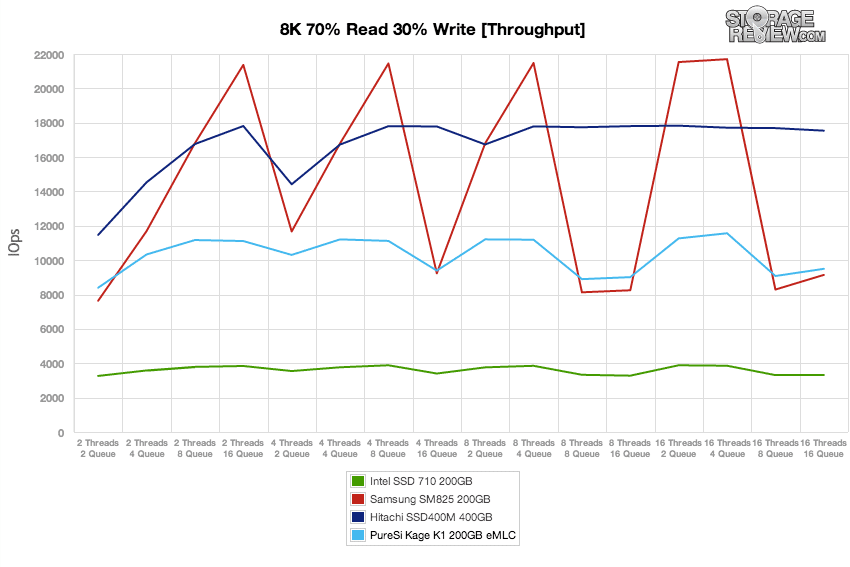
The K1’s 8K 70/30 average latency results are much more interesting, a neck and neck competition with the SM825.
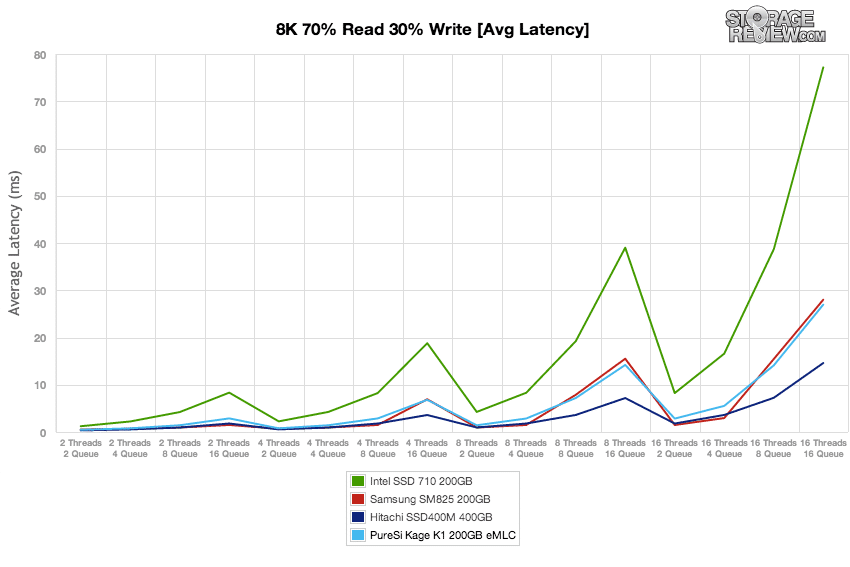
Maximum latency results are also comparable between the PureSi Kage K1 and the Samsung SM825 in the 8K 70/30 benchmark.
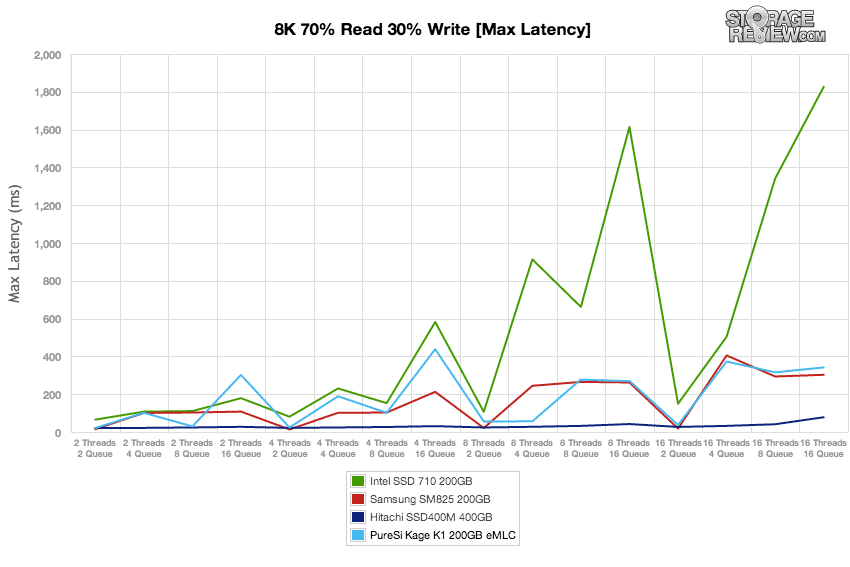
The latency performance similarities between the K1 and the SM825 are even clearer when plotted by standard deviation.
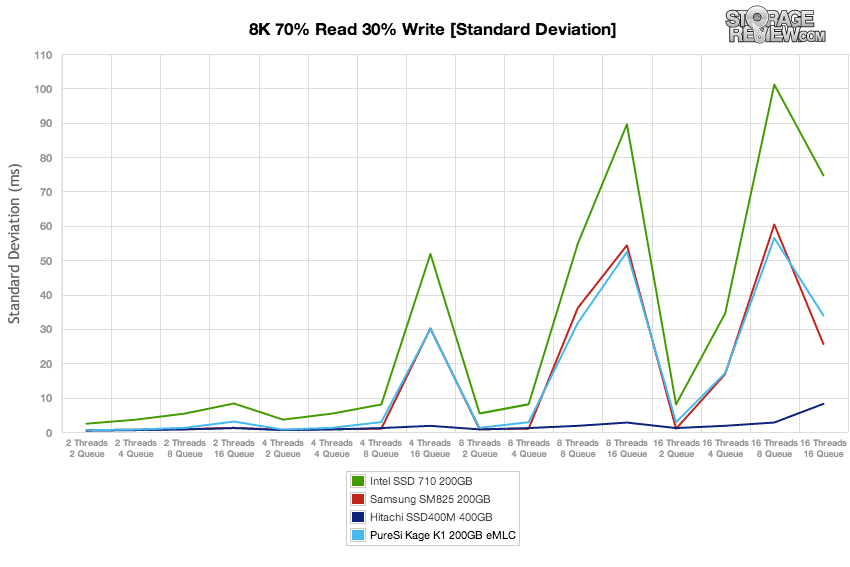
The file server profile uses transfer sizes from 512B to 64K to model the various workloads an SSD might be exposed to in the data center.
The Kage K1 has its best showing against the comparables to date in the file server preconditioning, winding up second only to the Hitachi SSD400M in IOps.
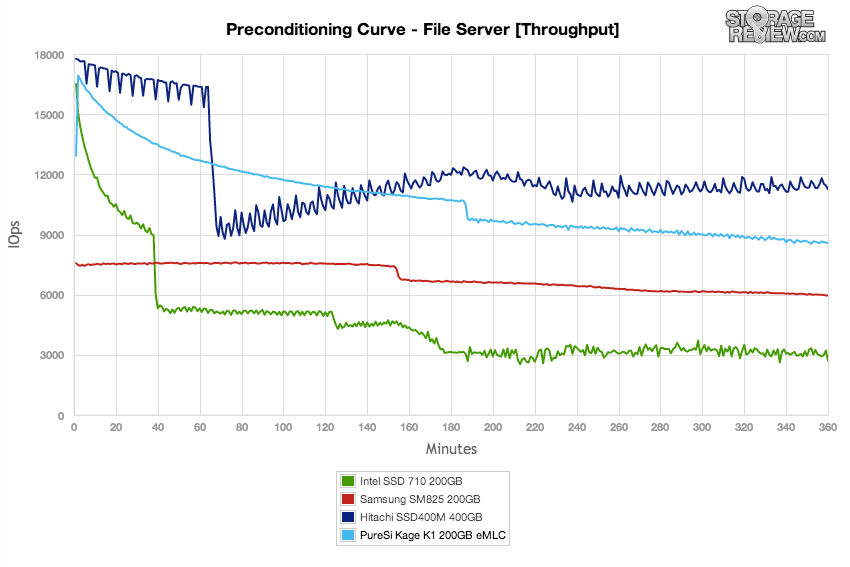
The Kage K1’s average latency also clocks in just above the SSD400M.
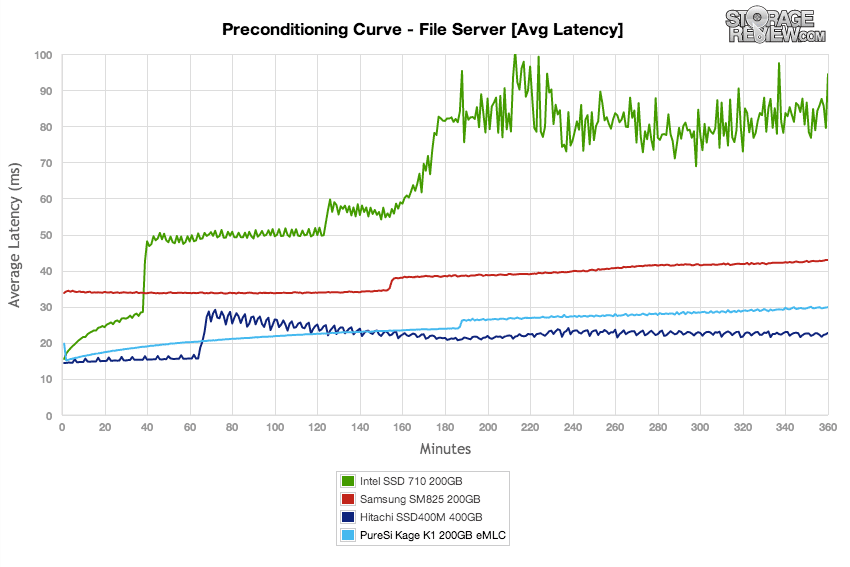
While not exhibiting spikes as high as the SM825’s highest results, the Kage K1 nonetheless generally hit second highest maximum latency throughout preconditioning, second to the Intel SSD 710.
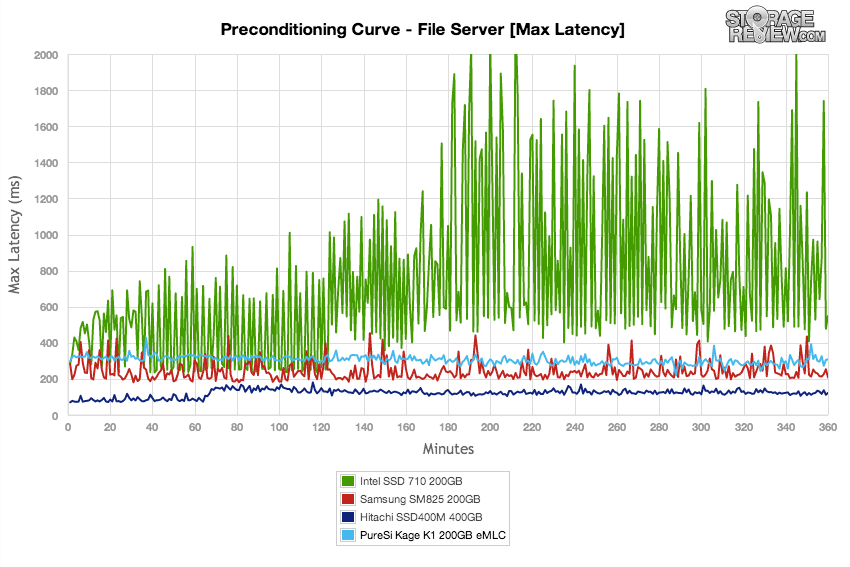
Plotted by standard deviation, the K1’s latency characteristics are a bit better than the SM825 during file server benchmark preconditioning.
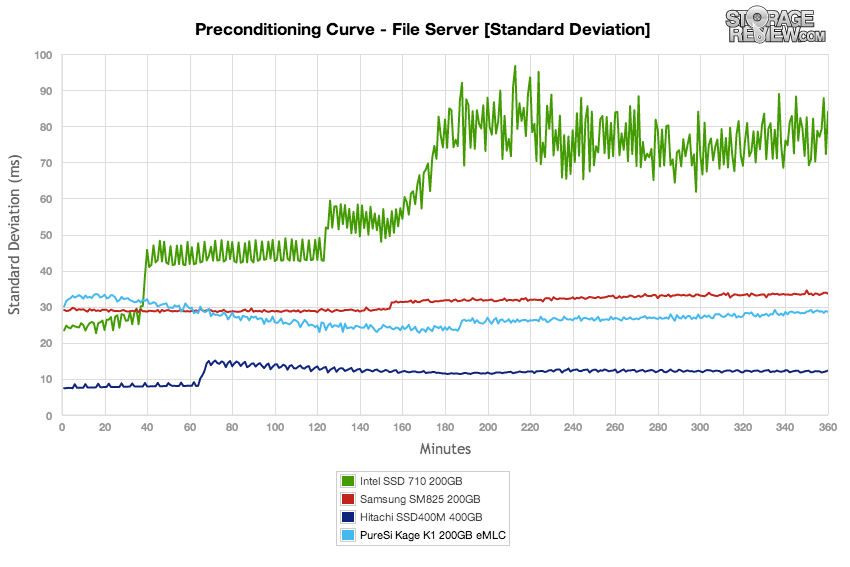
The Kage K1 turns in a very consistent performance during the file server workload itself, with comparable overall performance to the SM825 but across a narrower range of IOps as the number of threads and the depth of the queue varies.
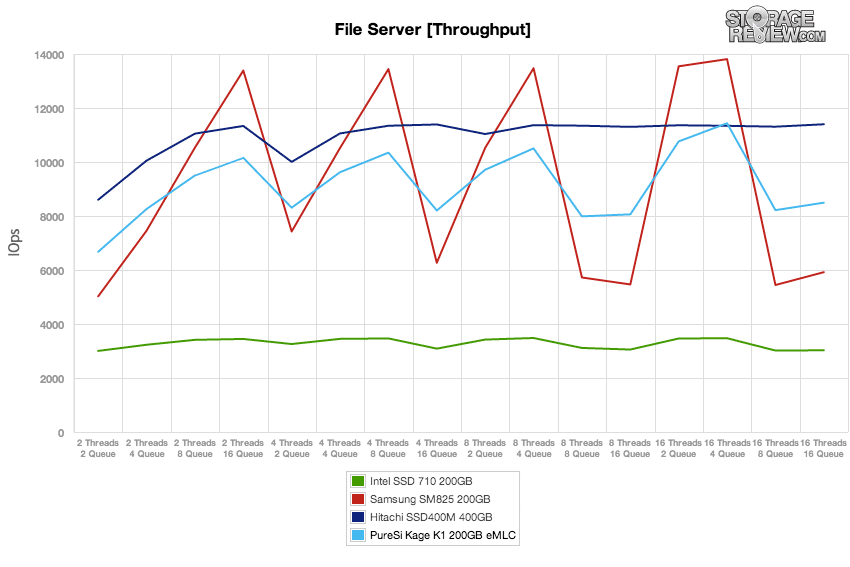
The Kage K1’s average latency is second lowest to the SSD400M throughout the file server benchmark.
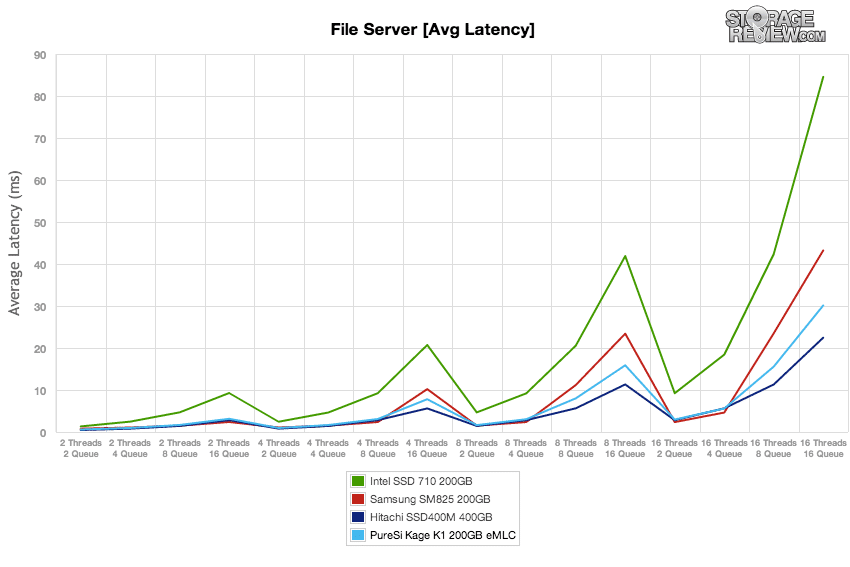
As in the 8K 70/30 benchmark, the maximum latency highlights similarities in maximum latency between the Kage K1 and the SM825, though specific inflection points vary between the two drives.
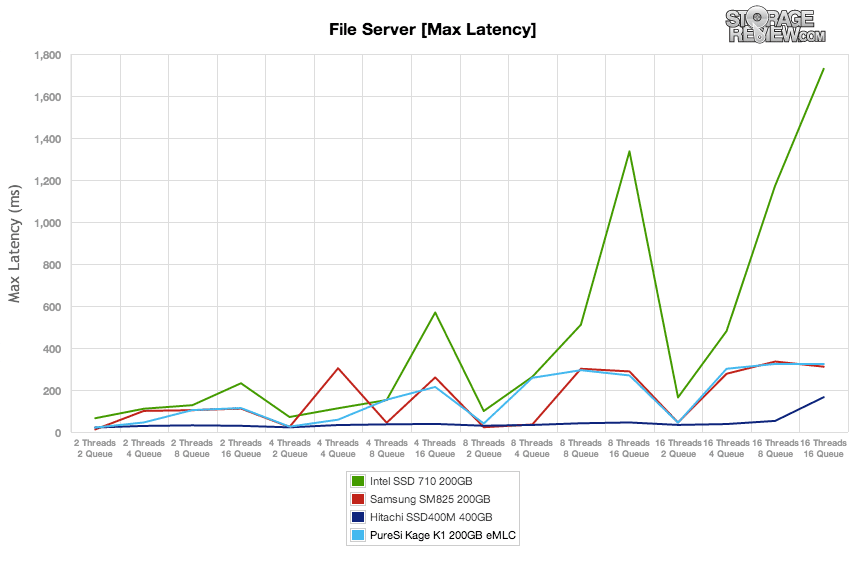
Charted by standard deviation, the Kage K1 earns a clear second place in latency, though sharing the comparable as the SSD 710 and the SM825 when the queue depth grows.
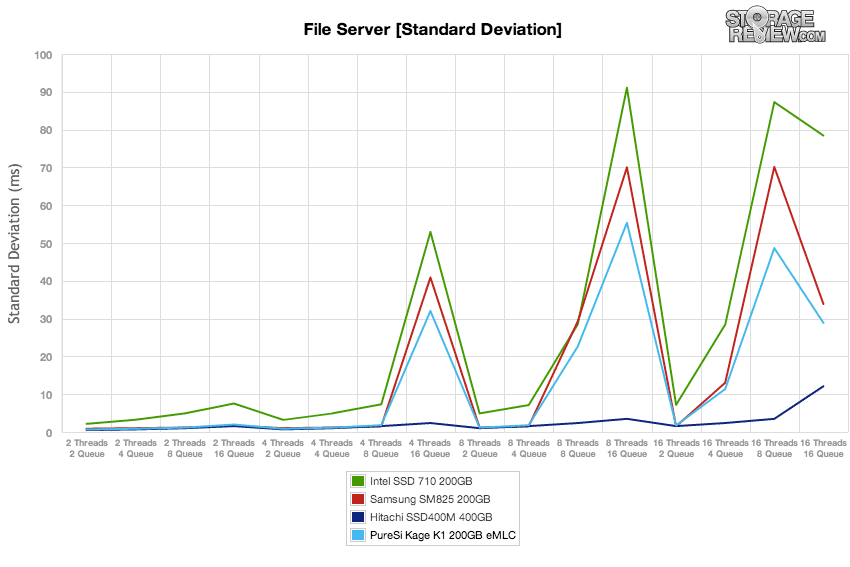
The preconditioning process for the web server profile reflects the fact that this profile models an application with 100% read activity. Our preconditioning process for the web server benchmark therefore uses 100% write operation, producing charts that will have more pronounced variations between performance during preconditioning and the during the actual workload.
The Kage K1 does not perform well against the comparables in write throughput, winding up finishing only above the SSD 710.
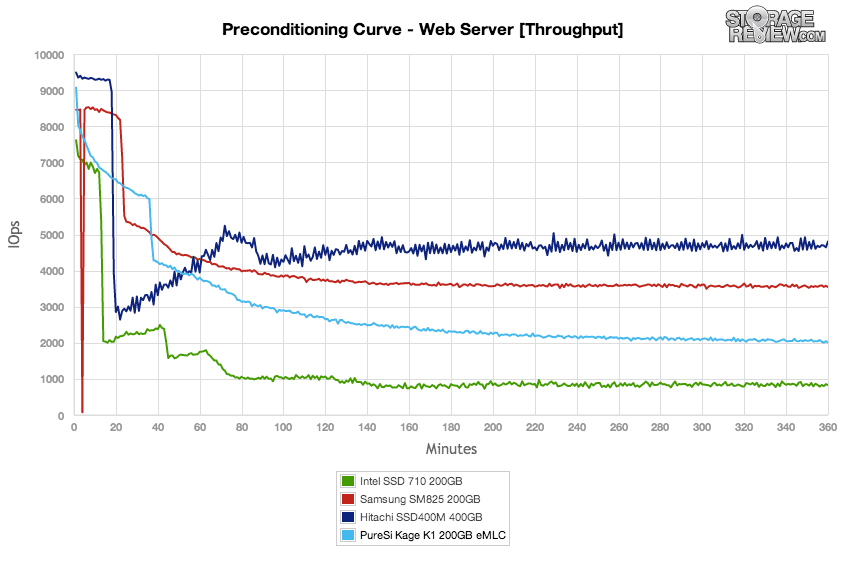
The average latency of the Kage K1 rises over the course of preconditioning to wind up well above the SSD400M and the SM825.
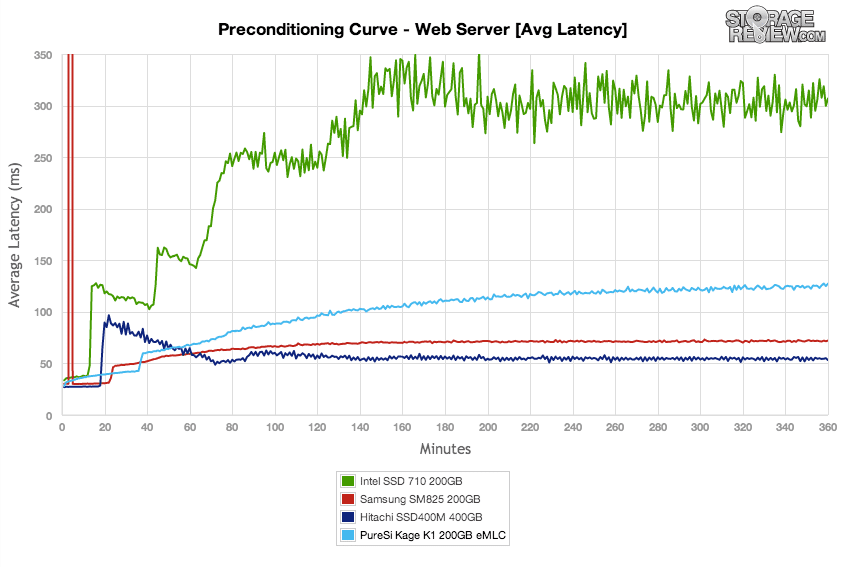
Variations in maximum latency kept within a relatively narrow range, but again highlighted the wide range of maximum latency performances across the eMLC drives.
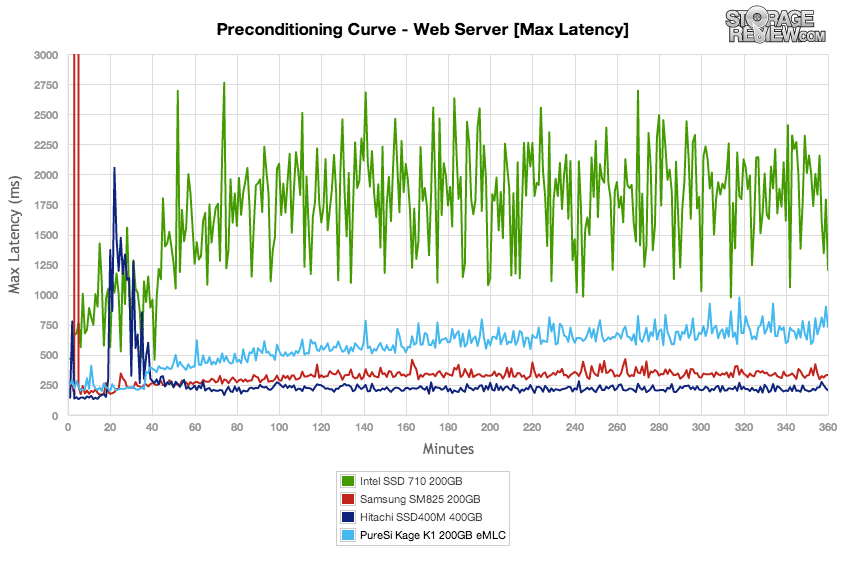
Plotted here as standard deviation, the K1’s latency is again hampered by the 100% write workload of our web server benchmark preconditioning.
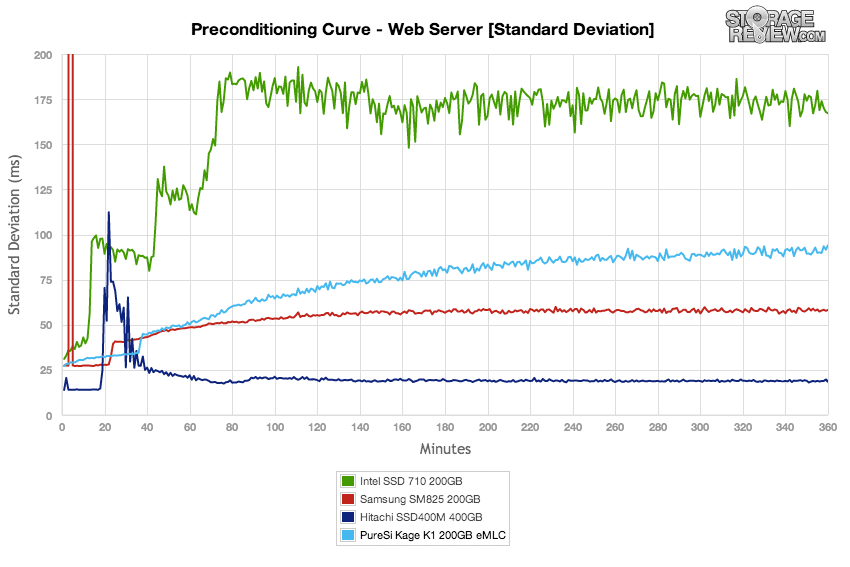
With preconditioning complete, the workloads for the web server benchmark itself will be 100% read operations.
The web server workload plays to the Kage K1’s strengths as it performs second only to the SSD400M in IOps during the web server benchmark.
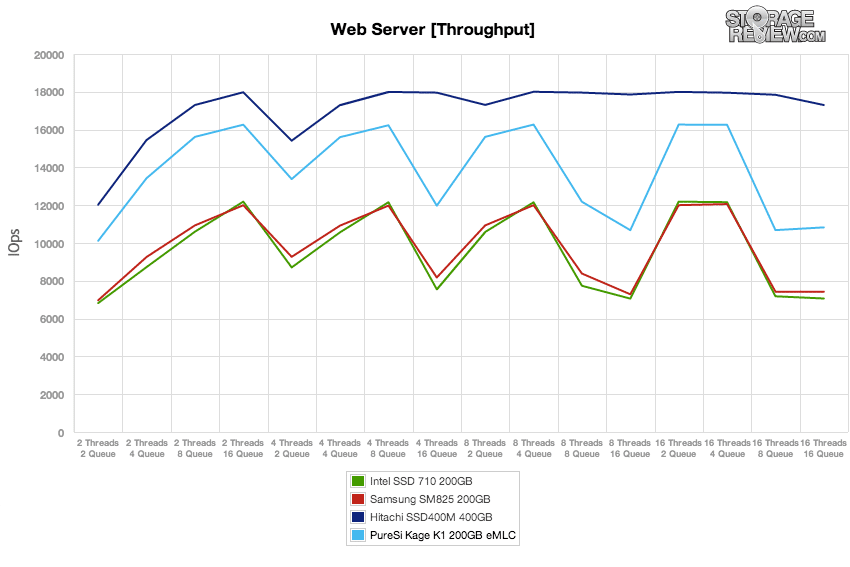
The Kage K1 winds up again in second position in the web server average latency results.
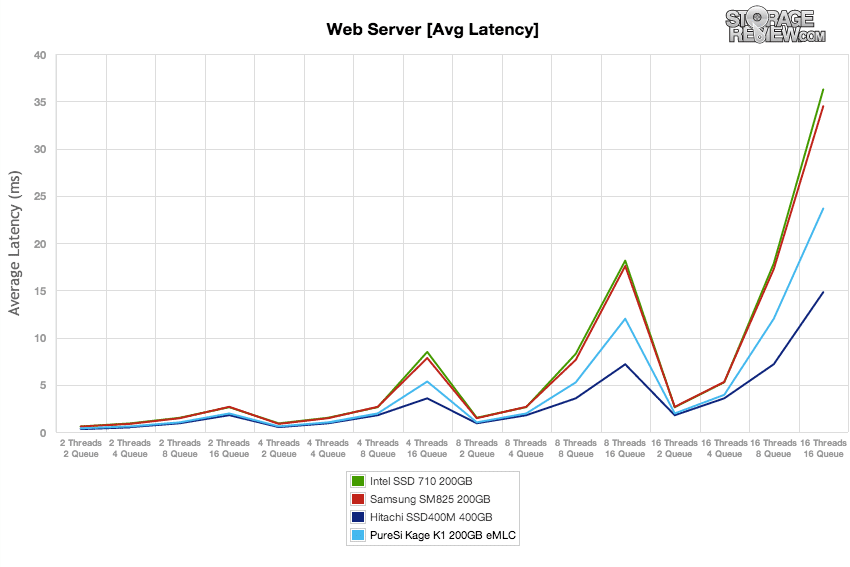
The Kage K1 and SM825 have similar maximum latency characteristics during the web server benchmark.
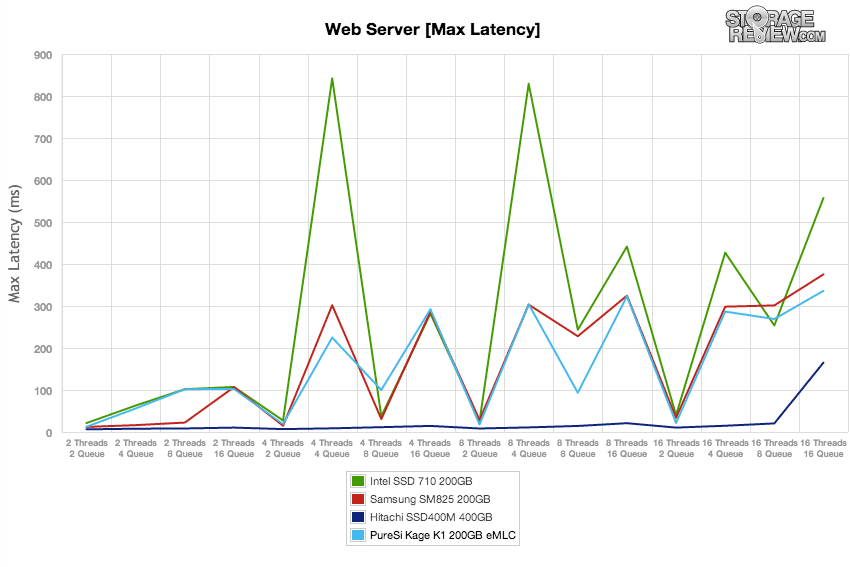
Plotted by standard deviation, the differences between the SSD400M and the other drives are put into contrast as the queue depth rises.
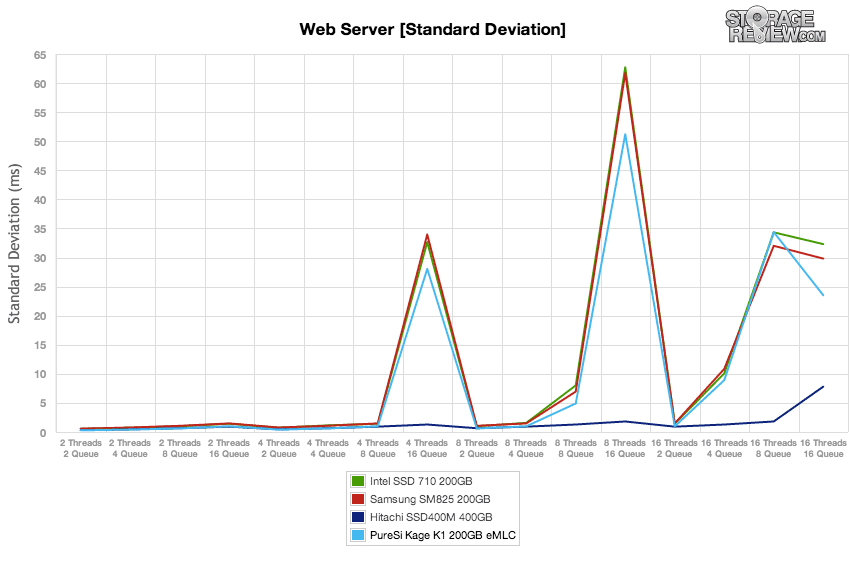
Conclusion
The pureSi Kage K1 SSD provides consistent performance across our range of benchmarks. Compared to the Hitachi SSD400M, which also costs much more, the Kage K1 SSD slips behind, but holds a middle ground with the other eMLC models we tested. Taking account the SandForce controller’s trouble with incompressible write operations, this drive can nonetheless compete favorably with Hitachi and Samsung’s offerings for many applications, and at a better price. It also offers a substantial lead in performance above the Intel SSD 710. The entry of newer manufacturers like pureSilicon into eMLC also bodes well for continued innovation in eMLC storage as the technology gains a foothold.
The Kage K1 CNC-machined case shows off pureSi’s attention to detail, that should provide excellent heat dissipation for the drive even as it adds some additional weight that might become a factor when comparing the Kage K1 to other eMLC drives for a large deployment. The Kage K1 also features pureSi’s VoltStream power supply technology, designed to protect in-flight data in the event of a power failure.

The pureSi Kage K1, like many other eMLC products, are designed to fit the market segment where you need the endurance of multiple drive-writes a day, but not as much as what a more costly SLC-based SSD would be capable of. Compared to the Intel SSD 710, which is closest towards the entry-level eMLC enterprise SSDs in terms of cost, the Kage K1 offers a substantial boost in performance. When compared against the upper-tier eMLC models such as the Hitachi SSD400M or Samsung SM825, performance is lower, but not that far behind. With power-fail protection, excellent thermal dissipation, endurance rated at 2.5PB (for the 200GB K1), and solid performance, the pureSi Kage K1 SSD has a lot to offer for the enterprise market.
Pros
- Strong performance in the file server and web server benchmarks
- Kage K1 SSD keeps max latency between 400-600ms in our testing
- Excellent CNC-machined case that pays attention to thermals
Cons
- Held back in areas with incompressible write-heavy workloads
Bottom Line
The PureSi Kage K1 makes a good showing for itself versus other first-generation eMLC drives and would be suitable across a number of applications. When compared against other more expensive eMLC SAS/SATA SSDs, performance isn’t the quickest, although it offers a much better value prop.
Availability
PureSi is now shipping K1E SSDs in 200GB and 400GB. 50GB, 75GB, 100GB, 150GB, and 300GB capacities will be available later this month.
pureSi 200GB Kage K1 at Amazon.com
pureSi 400GB Kage K1 at Amazon.com
pureSi Kage K1 SATA Product Page
